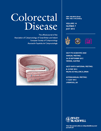Perianal necrotizing fasciitis treated with a loose-seton technique
Abstract
Aim The study evaluated the effect of a loose-seton technique for perianal necrotizing fasciitis.
Method The medical records of seven patients with perianal necrotizing fasciitis treated by the loose-seton technique between December 2005 and June 2010 were reviewed. Age, gender, status of diabetes mellitus, duration of symptoms, the length of hospital stay and number of debridements were investigated.
Results Five of the patients were men. The mean age was 53 years and the range was 43–79 years. All seven patients had a past history of acute perianal abscess. Six (85.7%) patients had diabetes mellitus. The mean time for removal of the seton was 24 (14–32) days and the mean hospitalization time was 31 (23–45) days. All patients had primary wound healing. There was no mortality. At a median follow-up 18 (6–60) months one patient required inpatient treatment with cutting-seton for complex anal fistula after 11 months. All patients had normal faecal continence and none of them required a reconstructive procedure during the follow-up.
Conclusion The loose-seton technique is an effective treatment for perianal necrotizing fasciitis. The advantages include inhibiting the spread of inflammation, reducing the frequency of debridements, decreasing the area of the wound and limiting extensive scar formation.




